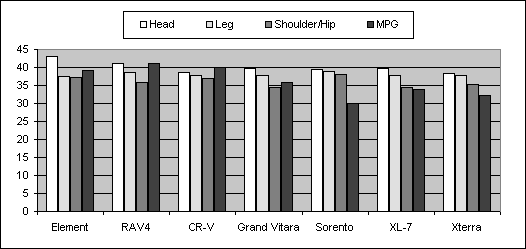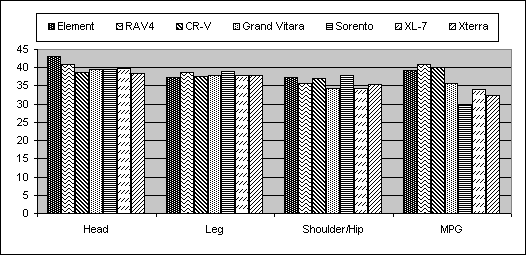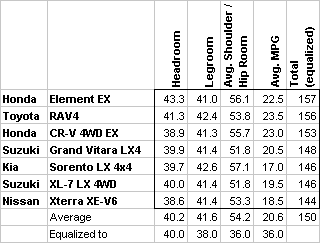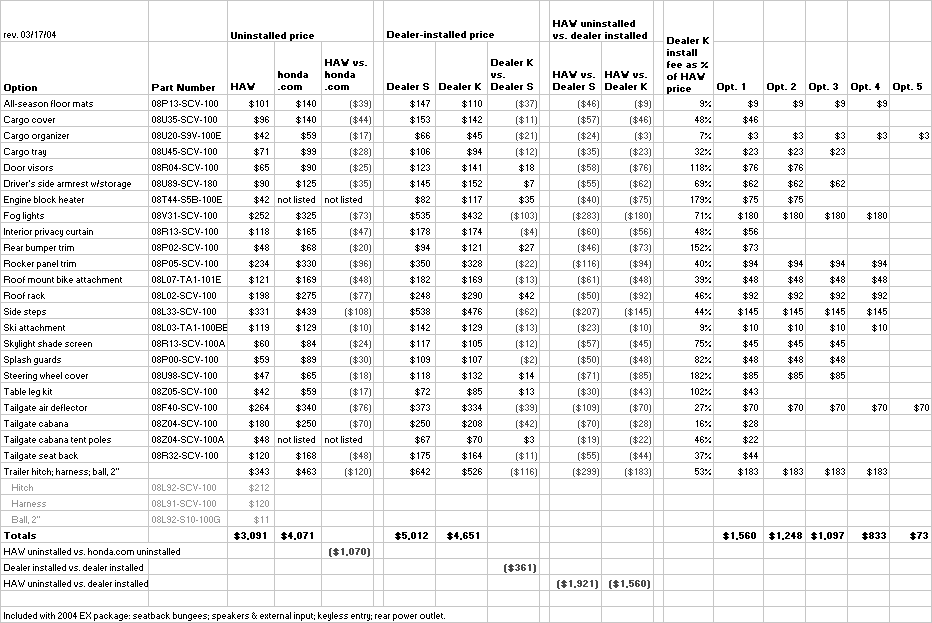How I Chose the Element
At the beginning of my search for a new vehicle (ca. January 2004), I decided to be methodical and not to be swayed by aesthetics or other intangibles. What follows is a summary of my methodology and conclusions.
First Cut
For me, it's all about interior space and flexibility, efficiency, and handling in the snow. I love minivans, but they're just too much vehicle for a single person, and they rarely come with four wheel drive, which I consider essential here in upstate New York. Thus I limited my search to small (but not tiny) SUVs and tall passenger cars. The basic requirements were 4WD and a manual transmission, preferably a 5-speed.
The 4WD/stick combination eliminated most of the models on the market, including the Honda Pilot, Pontiac Aztek and Vibe, and Saturn Vue, all of which could be had with 4WD or a stick, but not both. The Mazda Tribute almost made it, but the 4WD/stick combo was offered only on the base model, which lacked airbags, anti-lock brakes, and other desirable features.
These vehicles met the initial criteria:
- Honda CR-V
- Honda Element
- Kia Sorento
- Nissan Xterra
- Suzuki Grand Vitara
- Suzuki XL-7
- Toyota RAV4
The next criterion was interior room. I'm 6'5", 240 lbs., and too old to be crawling in and out of little cars. So I looked at
- front headroom,
- front legroom,
- front shoulder/hip room (averaged), and
- fuel economy (average city/highway).
The numbers in each category were compared by vehicle, then equalized, or weighted, according to importance: first headroom (equalized average of 40), then legroom (38), then shoulder/hip room (36) and mpg (also 36). This allowed me to compare apples to apples, since the raw numbers would have given too much weight to shoulder/hip room (raw average of 54.2) and too little weight to fuel economy (20.6).
I charted the data two ways: vehicle-by-vehicle, comparing ratings in each category (Chart 1), and category-by-category, comparing ratings for each vehicle (Chart 2). Chart 1 makes it obvious, for example, that the Element does best with headroom, well on fuel economy, and relatively poorly in leg and shoulder/hip room. Chart 2 shows, for example, that legroom is pretty close across vehicles, whereas fuel economy is all over the map.
 Chart 1 |
 Chart 2 |
Finally, I totaled each vehicle's numbers across categories and ranked the vehicles by those totals. The rankings:
|
 |
The Rear Hatch Problem
Around this time, I discovered what I consider to be an Achilles' heel for many small SUVs: a one-piece, side-hinged rear hatch that carries the spare tire.
First, one-piece hatches are big and heavy, hence likely expensive to repair or replace. Second, the side hinge makes it difficult to open the hatch fully in a tight parallel parking space. Third, having the hinges on the passenger's side forces you to stand out in traffic (since we normally park on the right) to open and close, load and unload.
Finally and most damning, the spare tire protrudes beyond the rear bumper, so if you get rear-ended or back into an obstacle, that big, expensive hatch absorbs the impact, instead of the bumper. I know someone with a RAV4 that she likes very much, but that car is currently on its fourth hatch! Since becoming aware of the issue, I have noticed quite a few vehicles on the road with stoved-in hatches where the spare tire used to sit.
The side-hinged hatch/spare tire problem removed the RAV4, CR-V, and both Suzukis (and the Jeeps, as it happens) from serious contention. That left the Element, Sorento, and Xterra.
The Xterra has a single, top-hinged liftgate like a minivan. The Sorento is similar to the Xterra, but the window hinges separately, making it easy to load small items in the back without having to open the liftgate. The Element has a split liftgate/tailgate. This is the best of both worlds: easy access to drop in a bag of groceries, minimal external clearance, yet full access to the interior. And you can sit or stand on the tailgate—pretty convenient!
In the Flesh
Then it was time to actually look at the cars. I took measurements, checked features, and recorded subjective impressions (on a 1–5 scale) of each car, using the following checklist:
|
Ingress/Egress head/leg/hip clearance rear cargo access (HxW) side cargo access (HxW) Driver's seat bottom (HxD) back height bolster lumbar adjustability general comfort |
Harness comfort adjustability one-handed operation Steering wheel adjustability armrest angle/comfort knee access horn button access other controls |
Controls lights wiper/washer heat, a/c, rear defrost audio cruise control other Instrument Cluster gauge layout/legibility illumination color |
Interior lighting cargo area (WxD) cargo floor flatness cargo visual security stowage Options pwr windows pwr locks side-mirror remote (pwr, man., none) |
Then I compiled a more extensive side-by-side comparison of Element and Sorento specifications, using data from honda.com, kiacars.com, and cars.com.
Briefly, the Sorento is more powerful than the Element and comes with more goodies (headlight washer, heated seats, etc.), but it is also more trucklike, with body-on-frame construction and a rigid rear axle. You can't leave it in 4WD. And the fuel economy is poor for a vehicle its size.
The Sorento drives nice, feels nice, and has a lot going for it, but nothing about the test drive wowed me enough to overcome the factors noted above. Also, I'm a tad nervous about Kia being around to support a vehicle I plan to keep at least 10 years. As a longtime Rambler-AMC owner, I'm sensitive to being orphaned, and I'd rather not need to join a Kia club in the future to find parts.
Accessories
Once I decided on the Element, I researched accessories. The 2004 EX comes with a/c, keyless entry, and a nice stereo, but I wanted lots of other goodies. Info and opinions gleaned from Element chat boards steered me away from some accessories, but it's still a long list.
The table below compares accessory prices (uninstalled) as quoted on the "Build and Price" section of the hondacars.com site and the Accessories section of hondacuraworld.com ("HAW"). It also compares installed prices from two local dealers ("S" and "K"); and compares savings on uninstalled vs. installed prices in a number of scenarios.
